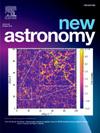Equilibrium points in the perturbed rotating mass dipole system with oblateness
IF 2.1
4区 物理与天体物理
Q2 ASTRONOMY & ASTROPHYSICS
引用次数: 0
Abstract
This paper discusses the existence, location, and liner stability of equilibrium points around a rotating dipole in the framework of the circular restricted three-body problem. The rotating dipole system consists of two finite bodies of masses and rigidly connected by a massless rod in a constant characteristic distance. The idea is to consider that the bigger primary body is an oblate spheroid and the smaller one is a point mass together with small perturbations in the Coriolis and centrifugal forces of the primaries. Firstly, these equilibria are determined numerically and, depending on the force ratio and mass factor values, their number may be three or five. It is found that the positions of these equilibria depend on all the system parameters except small perturbation in the Coriolis force. The linear stability of each equilibrium point is also examined. A simulation is done by using two typical highly irregular shaped asteroids, 216-Kleopatra and 1620-Geographos, for which it is found that three collinear and two non-collinear equilibria exist for each system. The positions of these equilibria and their stability as well as the zero-velocity curves under variations of the aforementioned perturbations have been determined numerically. It is seen that the positions of the equilibria are affected by the parameters of the problem, since they are shifted from the classical restricted three-body problem on the –axis and out of the –axis, respectively. The linear stability of these equilibria is investigated for the asteroid systems, and they are found to be linearly unstable.
具有扁率的扰动旋转质量偶极子系统的平衡点
本文在圆形受限三体问题的框架下讨论了旋转偶极子周围平衡点的存在性、位置和线性稳定性。旋转偶极子系统由两个质量为m1和m2的有限体组成,由一根无质量棒在恒定的特征距离上刚性连接。这个想法是考虑较大的原生体是一个扁圆球体,较小的原生体是一个质点,并且在原生体的科里奥利力和离心力中有微小的扰动。首先,这些平衡是数值确定的,根据力比和质量因子值,它们的数量可能是三个或五个。结果表明,除了科里奥利力的微小扰动外,这些平衡点的位置与所有系统参数有关。并对各平衡点的线性稳定性进行了检验。利用两个典型的高度不规则形状的小行星216-Kleopatra和1620- geograpos进行了模拟,发现每个系统存在三个共线平衡和两个非共线平衡。用数值方法确定了这些平衡点的位置及其稳定性,以及在上述扰动变化下的零速度曲线。可以看出,平衡点的位置受到问题参数的影响,因为它们分别在x轴上和x轴外从经典的受限三体问题中移出。对这些平衡的线性稳定性进行了研究,发现它们是线性不稳定的。
本文章由计算机程序翻译,如有差异,请以英文原文为准。
求助全文
约1分钟内获得全文
求助全文
来源期刊

New Astronomy
地学天文-天文与天体物理
CiteScore
4.00
自引率
10.00%
发文量
109
审稿时长
13.6 weeks
期刊介绍:
New Astronomy publishes articles in all fields of astronomy and astrophysics, with a particular focus on computational astronomy: mathematical and astronomy techniques and methodology, simulations, modelling and numerical results and computational techniques in instrumentation.
New Astronomy includes full length research articles and review articles. The journal covers solar, stellar, galactic and extragalactic astronomy and astrophysics. It reports on original research in all wavelength bands, ranging from radio to gamma-ray.
 求助内容:
求助内容: 应助结果提醒方式:
应助结果提醒方式:


